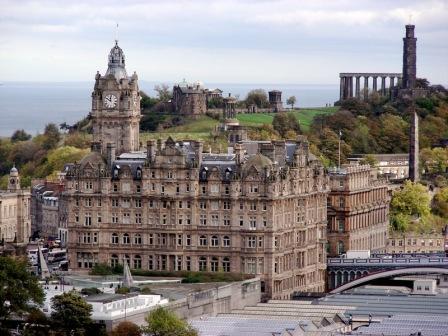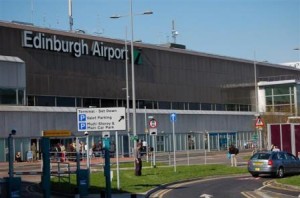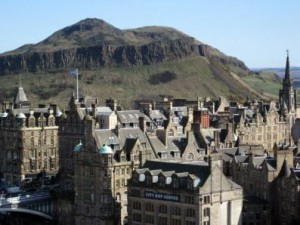
Carlton Hill, Edinburgh - © Thierry from Le Plessis Robinson, France
Edinburgh the capital city of Scotland has long been a favourite among tourists, there is plenty to see and do for visitors here. The city is a historic and scenic one and has been described as one of the most beautiful cities in Europe. The city districts of the Old and New Towns form the basis for the Edinburgh World Heritage Site (WHS), Edinburgh attained WHS status in 1995, an acknowledgment to the importance of the history, architecture and planning of the city. For visitors the compact nature of the city makes it possible to visit many of the attractions by foot and relatively easy to get around. The city is becoming ever more popular with visitors from across the UK and abroad, it has become a favourite short break destination whilst the Hogmanay year end celebrations attract many visitors from around the world.
Overview
The Old and New Towns of Edinburgh are the best known districts in the city and form the basis of the World Heritage Site in the city. The Old Town of Edinburgh contains a number of historic and architecturally importance buildings. There are a number of buildings still present from the Reformation era, perhaps the best known road is the Royal Mile that is the centrepiece of the area. The Royal Mile runs from Edinburgh Castle to the Palace of Holyroodhouse and the Scottish Parliament, the area has a number of sloping streets and has retained much of the character and charm that the area has become associated with.
The area also contains a number of notable buildings such as the General Assembly Hall of the Church of Scotland, the Royal Museum of Scotland, the University of Edinburgh and a variety of underground streets and vaults that represent a legacy of previous construction. The street layout is reminiscent of many European old towns and districts, however given Edinburgh is a scenic and picturesque city makes it pleasing on the eye.
Given the restrictions on space in the Old Town, the area is an early exponent of high rise residential buildings, with space at a premium, buildings were built upwards instead of outwards. There have been fires over time that has affected the Old Town most notably in 1824 when many buildings were destroyed and more recently in 2002.
The New Town of Edinburgh came about with the crowding being experienced in the Old Town and the need for more space and an expansion in the town. The design of James Craig for the New Town was chosen in the 18th century, it was from this design that the now famous Georgian architecture came about. The Georgian architecture today provides the backdrop to the range of bars, shops and restaurants that are present in the area. George Street formed the centrepiece of the New Town plan, built at 100 feet wide.
The New Town was built from 1765 to 1850 in a number of stages, the city has retains much of the architecture of the period. The New Town is regarded by many as a great piece of city planning that had a great impact and influence on European urban planning thereafter. Other famous streets in the district include Princes Street and Queen Street, it is Princes Street that is the most famous street and the heart of Edinburgh’s Shopping with its fine range of shops, the street runs for approx one mile. Princes Street has few buildings on its south side allowing for views of the Old Town on its south side.
The New Town has been extended and built up further many times in its history and the quality of the architecture set high standards for not only the UK but in Europe too. Edinburgh with both the Old and New Towns have had an impact on both town planning and urban architecture not only in the UK but further a field across Europe.
Edinburgh has benefited from the planning and construction of both the Old and New Towns, the alignment of the buildings results in a great views and panoramas for the city. The skyline has become a famous one and the city has retained much of the iconic buildings all of which have helped to distinguish Edinburgh and ensure the WHS status.
For visitors the Old and New Towns offer plenty to see and do, there is plenty of history and culture on offer, good shopping facilities and a range of entertainment venues to choose from. The New Year Hogmanay celebrations are among the largest in Europe and attract large numbers of local and international visitors, allowing visitors to combine a visit to the historic city with a chance to experience and join in with the New Year’s festivities.
How To Get There
The Scottish capital is accessible by both car and public transport:
By Car:
The city of Edinburgh is linked on the Scottish motorway network, The M8 motorway from Glasgow and the A74(M) from England provide access to the city. Edinburgh is approx 2 hours drive from Aberdeen, 2 and half hours from Newcastle, 4 hours from Manchester and 5 and a half hours from Birmingham.
Getting Around by Car in Edinburgh
Car drivers should take note that whilst it is relatively straight forward to drive to Edinburgh, driving around with the various parking restrictions requires drivers to follow the rules, stay alert and be vigilant.
City par parks provide car parking however drivers should park only if they fully understand the rules. Parking enforcements are strict, to avoid fines and other sanctions always follow the rules and beware of confusing rules and regulations.
By Train:
There are regular train services from London (king's Cross) to Edinburgh (Waverley station), the journey time is a little under 5 hours and the National Express line is currently the fastest intercity railway in the UK.
ScotRail operate an alternative overnight service, the Caledonian Sleeper, between takes passengers from London (Euston Station) and Edinburgh 7 nights a week.
Edinburgh (Waverley) station has good rail links to other UK cities such as Aberdeen, Newcastle and York. Scotland's largest city of Glasgow is a 50 minute train ride away from Edinburgh.
Edinburgh has two main train stations namely Edinburgh Waverley located in the city centre and Edinburgh Haymarket station located in the West End.
By Bus/Coach:
There are a number of bus and coach operators that run services to Edinburgh, these include:
Mega Bus offers a number of routes to Edinburgh from cities across the UK.
National Express offer a number of services in to and out of Edinburgh from a range of UK towns and cities.
Getting Around by Bus in Edinburgh
The Edinburgh local bus network services Edinburgh and the surrounding areas, there are frequent services making getting around the city relatively easy. Lothian buses offer day Tickets allowing for unlimited travel on buses in the area for the day, offering a good cost effective solution for visitors.
The various Edinburgh bus tours that provide sightseeing tours of the city offer another way to see and get around the city.
Contact Details
Address:
Scottish Booking & Info Centre
Fairways Business Park,
Deer Park Avenue
Livingston,
EH54 8AF,
Scotland
Telephone: 0845 2255 121 (from the within the UK)
Telephone: +44 (0)1506 832 121 (from outside the UK)
Fax: +44 (0)1506 832 222
email: info@visitscotland.com
Website: Edinburgh Tourism
Facilities and Information
Further Information:
For further information and tips for travellers on Edinburgh including Attractions, Places of Interest, Local Hotels, Restaurants and Entertainment venues please see: Edinburgh & Lothians Guide for useful tourist information and travellers advice.
Map
View Larger Map
For Local Search and Directions see: Edinburgh Old & New Town Map
Tips & Other Considerations
There may be some variations on the opening hours of attractions depending on the time of year and other factors. Visitors are advised to double check before going & avoid disappointment.
When travelling always remain alert and aware of your surroundings and environment. Follow sensible travel safety tips & ensure your belongings in particular your wallet/purse and valuables are hidden away from public view (particularly at tourist attractions & places with crowds). If you have a bag try to use a shoulder bag with a good quality, strong strap, that is put across your shoulder not on your shoulder making it more difficult for anyone to take your bag.
If you are travelling by car to Edinburgh ensure you are well prepared with maps and Sat Nav to aid your journey, particularly if you are not familiar with the local area and roads. Use the Route & Journey Planning tool for door to door directions for car journeys and public transport.
If you are looking for local car parking in Edinburgh, ensure you fully understand the rules, regulations & charges for car parks and street parking before you park your car. Car parking rules are rigorously enforced and any infringement of the rules can result in vehicles being fined, clamped or towed away. The rules & regulations can be complex if you are not sure it is wise not to park there.
If you are travelling by public transport, check for service updates prior to beginning your journey for any delays, disruption or cancellations to services that may impact on your journey. Ensure you have the service timetables for the trains, buses and coaches. Remember when the last services are and ensure you make it to the train/bus/coach stops well in time to avoid missing the service.
Disclaimer: The information given in on this website is given in good faith and to the best of our knowledge. If there are any discrepancies in no way do we intend to mislead. Important travel details and arrangements should be confirmed and verified with the relevant authorities.



